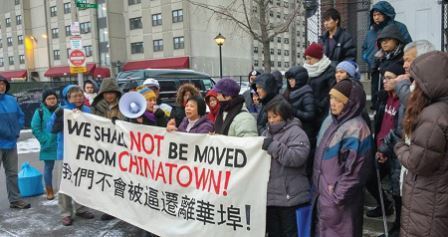Boston: Counting Costs of Gentrification

Two visions of city-making clash in Boston’s Chinatown. City planners and investors have been seeking to transform the traditional neighborhood with its distinct Chinese cultural and demographic character into a homogenized urban project. However, the process was not complete before students and professors at the Displacement Research + Action Network (DRAN) at Massachusetts Institute of Technology (MIT) joined the local community to measure what was being lost by gentrification.
The DRAN team applied a human rights frame of analysis and methodology developed by Housing and Land Rights Network to assess the impacts of displacing the region’s Chinese community at its center. Historically, the neighborhood has offered much needed affordable housing, social networks, multilingual social services, job markets and cultural cohesion. However, the waves of gentrification in the USA, fueled by a speculative housing market, has combined with mounting forced evictions and a legacy of failed affordable-housing policy to drive up rents, making it impossible for many residents, especially in vulnerable minority and immigrant communities, to remain in their neighborhoods. The DRAN study of Boston’s Chinatown displacement provides a granular look at the components of loss, cost and damage that the community has been forced to bear.
In Boston, Chinatown is among the frontlines of these pressures, as luxury residential development, short term rentals, institutional expansion and rising rents converge to deepen the commodification of neighborhood and reduce housing stock. The community’s visible and subliminal impacts include direct displacement, adverse health conditions, diminished access to services and community assets, loss of social capital, community fragmentation and rising costs in time and treasure to maintain regular functions.
DRAN partnered with the Chinese Progressive Association (CPA) to conduct a detailed analysis of the impacts displacement is having on residents and the neighborhood, correlating these consequences with applicable international human rights standards. The outcome is an analysis that can determine not only whether a violation occurred, but also how and to which measurable degree.
The first part of the collaboration examined the contemporary displacement and eviction crisis in the neighborhood through a mapping and spatial analysis using demographic and housing data. Then the partners adapted the impact-assessment tool, conducting the survey in both Cantonese and Mandarin languages.
The empirical findings of the report indicate the need for legislative and policy measures to protect vulnerable groups, address the fundamental drivers of displacement, provide rental assistance to reduce financial burdens, address health concerns of those who are facing displacement, improve the physical conditions of private rental housing, better communicate the rights of people in the displacement process, and take other specific measures to improve tenure security and reduce vulnerability.
It posits that reducing the negative drivers and impacts of displacement would help realize the human right to adequate housing in Boston and the USA. The conclusions point to the primary responsibility of local governments and authorities for protecting the human rights of all their residents against costs and losses of displacement. It calls for a challenge to conventional thinking around housing in the in the United States, which avoids recognizing housing as a human right. In doing so, the DRAN/CPA team calls for their City of Boston and the State of Massachusetts to show the way nationally by making such assessments compulsory in urban development.
Download Boston’s Chinatown: Forced from Home.
Photo on front page: The Boston Chinatown gate. Source: From the cover of Boston’s Chinatown: Forced from Home. Photo on this page: Boston Chinatown resi
|